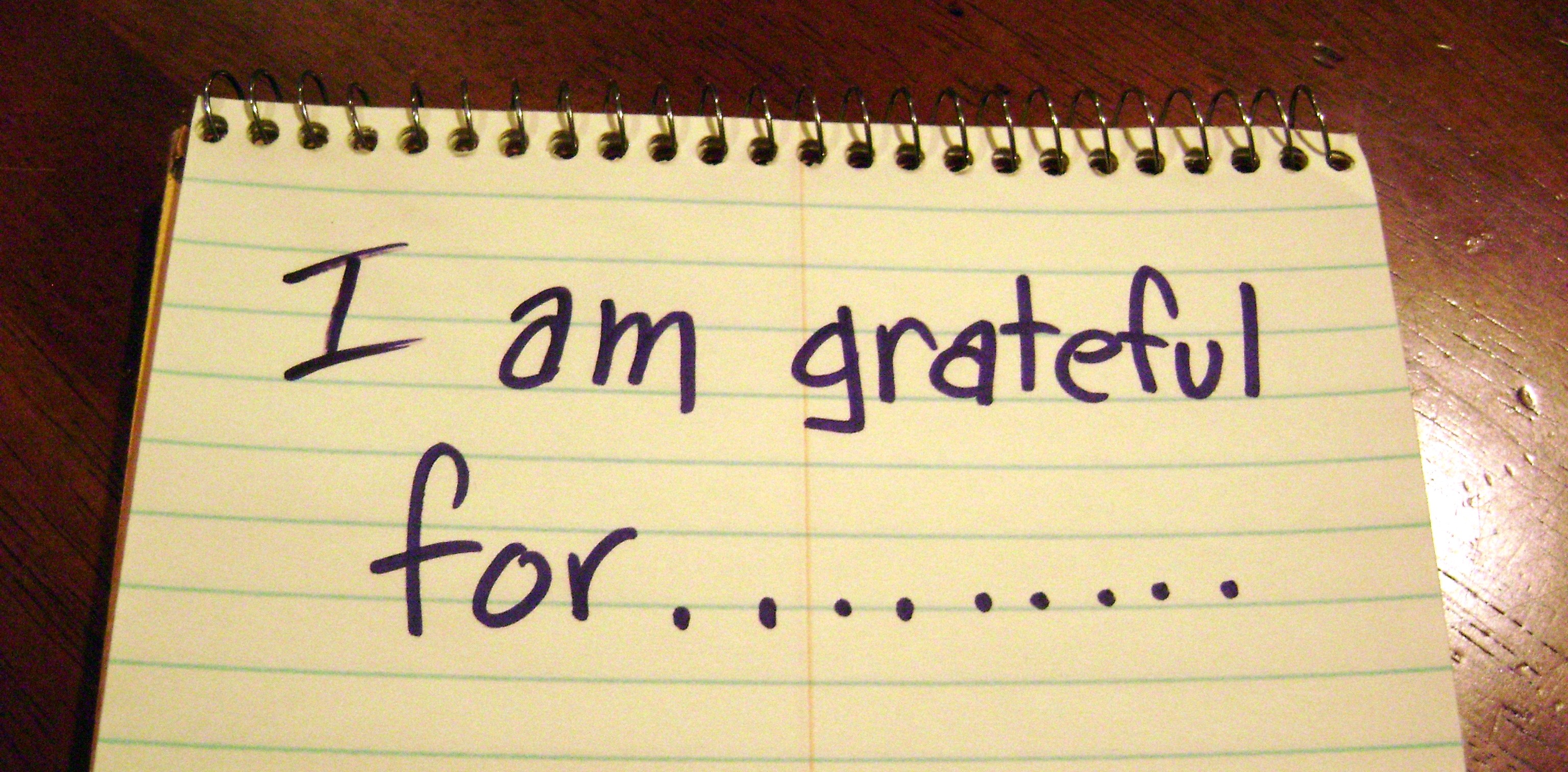October 3rd, 2016 · Comments Off on Use Gratitude to Be Happier
This article is in our series about increasing happiness and life satisfaction. Many people with chronic pain can’t decrease their pain. So another way to live a more enjoyable and fulfilling life – perhaps even more important – is to increase the positive. That’s what we’ll be looking at in this series.

The first way we’ll look at to increase positive emotions is gratitude.
Gratitude is noticing what you are grateful for and saying thanks. It can be for something small:
-
- a warm, rich cup of coffee
-
- your friend forwarding you a funny joke
- the perfect afternoon temperature for your walk
And it can be for something big:
- your 20th wedding anniversary, married to your best friend
- your kids turning out to be wonderful people
- a 2 week vacation in Hawaii
As we said previously, our brains are wired to notice the negative, so we need to make an effort to notice good things. And I’ve found that when I make an effort to notice positive things, I find more and more things to be positive about! A good cycle! Research confirms that practicing gratitude makes you happier.
Your assignment: Notice 3 things each day that you’re grateful for.
Keep a running list all day or spend a few minutes every evening remembering 3 good things from your day.
More info about gratitude:
***To get every new article delivered to you for free the instant they're published, sign up for How to Cope with Pain by email or RSS feed.
Tags: 1
September 26th, 2016 · Comments Off on The Benefits of Positive Emotions
This article is in our series about increasing happiness and life satisfaction. Many people with chronic pain can’t decrease their pain. So another way to live a more enjoyable and fulfilling life – perhaps even more important – is to increase the positive. That’s what we’ll be looking at in this series.

Our brains are more likely to focus on the “negative”:
- anxiety makes us try to prevent something harmful from happening
- fear makes us run away or fight
- sadness makes us try to fix a bad situation
Evolutionarily, our focus on the negative made our survival more likely – we stored enough food because we were anxious about having enough, and we ran away from the lion.
Do positive emotions help us in any way? What do happiness, joy, laughter, and calm do for us?
Well, lots! When feeling good, we:
- handle problems more positively
- are more creative
- are more accurate in our assessment of negative information
- have better health
- are more productive
- enjoy more social involvement
But don’t take my word for it. For a week, notice what’s different when you are happy. Are you more creative – for example, in your artwork or solving a problem? Are you more able to look at a challenge realistically and come up with a solution, instead of getting into a downward spiral of worry? Is your heart rate lower? Do you hang out with friends and family more?
Investigate as a researcher would – see what you notice.
***To get every new article delivered to you for free the instant they're published, sign up for How to Cope with Pain by email or RSS feed.
Tags: 1
September 19th, 2016 · Comments Off on Notice What Makes You Happy
This article is in our series about increasing happiness and life satisfaction. Many people with chronic pain can’t decrease their pain. So another way to live a more enjoyable and fulfilling life – perhaps even more important – is to increase the positive. That’s what we’ll be looking at in this series.
Based on your own life, what you think the things are that go into a happy life. Initially you might have said travel around the world and lots of chocolate. Or winning the lottery and marrying a gorgeous partner. Or perhaps you might think you have to avoid everything that’s negative – have no pain or stress. Nope.
For a week, pay attention each day to what makes you happiest. You can also take this Emotions Questionnaire to score your happiness (you will have to register at the site).
***To get every new article delivered to you for free the instant they're published, sign up for How to Cope with Pain by email or RSS feed.
Tags: 1
September 12th, 2016 · Comments Off on What Makes You Happy?
This article is in our series about increasing happiness and life satisfaction. Many people with chronic pain can’t decrease their pain. So another way to live a more enjoyable and fulfilling life – perhaps even more important – is to increase the positive. That’s what we’ll be looking at in this series.
You can take a very short happiness quiz (you will have to register at the site) to see where you are currently. Before beginning a series of exercises to see what helps you most to increase your happiness, what do you believe makes up a happy life? Both research and different cultures say that a collection of things helps people be happy. From your own life, what do you think they are?
***To get every new article delivered to you for free the instant they're published, sign up for How to Cope with Pain by email or RSS feed.
Tags: 1
September 6th, 2016 · Comments Off on Increasing Your Happiness
This is a series of articles about increasing happiness from the perspective of positive psychology. I hope you’ll follow along and try some of the exercises!
Positive psychology looks at ways to promote happiness and life satisfaction. It differs from what has been the main focus of psychiatry and psychology, which has been to study and treat mental illness.
I believe this focus is very important for people with chronic pain. I talk with my patients about 2 main ways to live a more enjoyable and fulfilling life. One, of course, is to decrease pain – lessen the negative in your life. This website presents many, many ways to do that (here, here and here, for example). Unfortunately for many of us, reaching lower pain levels may not be possible. We’re stuck with chronic pain – sometimes at high levels.
So another main way to increase happiness and satisfaction is to focus on increasing the positive, rather than decreasing the negative. Positive psychology does that.
Research in positive psychology tells us that what will make us happier is:
- practicing gratitude
- challenging our negative thoughts
- increasing optimism
- adding pleasures to our lives (even simple things like morning coffee and flowers on our desk)
- increasing our enjoyment of these pleasures by using mindfulness, sharing with others and remembering enjoyable things
Our life satisfaction can be increased by:
- using our “core strengths” every day
- being part of something bigger to increase meaning in our lives
I invite you to take a very short happiness quiz (you will have to register at the site) to see where you are currently. (It is from the Penn Authentic Happiness website. You may need to register to access the quiz.)
***To get every new article delivered to you for free the instant they're published, sign up for How to Cope with Pain by email or RSS feed.
Tags: 1
May 11th, 2016 · Comments Off on Living With, and Managing, Chronic Pain
This story appeared in Practical Pain Management about a person’s coping skills for living with chronic pain and how she handles the challenges that pain presents. I hope it will encourage you to share your story and your coping skills to help others.
Living With, and Managing, Chronic Pain: A Patient’s Story

***To get every new article delivered to you for free the instant they're published, sign up for How to Cope with Pain by email or RSS feed.
Tags: 1
March 21st, 2016 · Comments Off on Pain Management Class: Stress Management, Part 2
This article is in our series featuring pain management techniques to help you decrease and cope with pain. It’s your at-home pain management class!
Most people report that stress increases their pain levels. So it’s important to both prevent and decrease stress. This article invites you to pick 1 stress management technique to try. Why pick just 1? You’ll have more success if you change 1 thing at a time.
Pick a specific way to decrease your stress.
Your assignment: Pick 1 stress management skill you’d like to work on. Fill in the worksheet and practice this skill this week (click the above link to get to the worksheet).
***To get every new article delivered to you for free the instant they're published, sign up for How to Cope with Pain by email or RSS feed.
Tags: 1
March 14th, 2016 · Comments Off on Pain Management Class: Stress Management
This article is in our series featuring pain management techniques to help you decrease and cope with pain. It’s your at-home pain management class!
For most people, stress increases their pain levels. So it’s important to both prevent and decrease stress. Here’s a stress management exercise for you to review. It lists many ways to decrease stress!

Your assignment: Pick ONE stress management skill you’d like to try out this week. Write it down where you’ll see it every day.
***To get every new article delivered to you for free the instant they're published, sign up for How to Cope with Pain by email or RSS feed.
Tags: 1
March 7th, 2016 · Comments Off on Pain Management Class: Guided Imagery, Part 2
This article is in our series featuring pain management techniques to help you decrease and cope with pain. It’s your at-home pain management class!
Guided imagery reduces pain through suggestion and images. An image is paired with your pain, and by decreasing or changing the image in some way, your pain may also decrease. Today’s guided imagery uses a sunset as the image.

Guided imagery with a sunset image
There are several ways to use this exercise:
- listen to the exercise in the audio on the website
- read through the exercise and then do it from memory (it doesn’t have to be done exactly as I’ve written it)
- tape record the exercise yourself, then play it back for yourself to do (you can even record it into your cellphone)
- have someone else read or record the exercise for you
As you try this guided imagery, see if you begin to benefit even more than with a plain relaxation exercises.
Your assignment: Do a guided imagery exercise at least once a day.
***To get every new article delivered to you for free the instant they're published, sign up for How to Cope with Pain by email or RSS feed.
Tags: 1
February 29th, 2016 · Comments Off on Pain Management Class: Guided Imagery
This article is in our series featuring pain management techniques to help you decrease and cope with pain. It’s your at-home pain management class!
Guided imagery helps reduce pain even more directly than relaxation exercises through the use of suggestion. An image is paired with your pain, and by imagining decreasing or changing the picture in some way, your pain may also decrease. This exercise uses the image of special water.

Guided imagery of water
There are several ways to use this exercise:
- listen to the audio on our website
- read through the exercise and then do it from memory (it doesn’t have to be done exactly as I’ve written it)
- tape record the exercise yourself, then play it back and listen (record it in your cellphone!)
- have someone else read or record the exercise for you
As you try guided imagery, notice if you benefit even more than from using relaxation exercises.
Your assignment: Do a guided imagery exercise at least once a day
***To get every new article delivered to you for free the instant they're published, sign up for How to Cope with Pain by email or RSS feed.
Tags: 1





